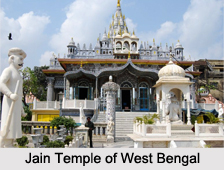 Jain Pilgrimages are located all over India. The map of Jain sacred geography is continually changing, with hierarchies of temples and religious sites evolving over time. There are some places that boast local fame while others enjoy a supra-regional status and contribute to defining community identity. In the medieval period, strategies developed to expand the circuit of pilgrimage sites and to promote new places, as older ones became inaccessible.
Jain Pilgrimages are located all over India. The map of Jain sacred geography is continually changing, with hierarchies of temples and religious sites evolving over time. There are some places that boast local fame while others enjoy a supra-regional status and contribute to defining community identity. In the medieval period, strategies developed to expand the circuit of pilgrimage sites and to promote new places, as older ones became inaccessible.
Jain Pilgrimages in East Indian States
The eastern part of India, especially that area corresponding to the modern states of Bihar and Jharkhand, was where Mahavira was born, lived and taught. Some important holy places are connected with events in his life and in the lives of other Jain Tirthankaras.
Pawapuri is the small place where Mahavira died. Every year it becomes a vibrant pilgrimage site at the time of the Diwali festival, which commemorates Mahavira"s liberation. It is a place of great scenic beauty, particularly when the lotus flowers are in bloom on the large lake.
Sammet Shikhar, also known as "Sammeta Sikhara", is the mountain where 20 out of the 24 Jain Tirthankaras attained Nirvana or Moksha. The mountain rises handsomely from forested lower slopes to its rugged peak and the summit is covered with temples. As they exist today the temples are all relatively modern, the finest one, on the south-east, with its five fluted domes, contains an image in black marble of Lord Parshvanatha, the 23rd Tirthankara, dated 1765 on its base. Large numbers of pilgrims come to this place, the most pious, after visiting every shrine; conclude their pilgrimage by walking the 30 mile circuit of the base of the hill.
Like Magadha, the kingdom of Kalinga or Odisha had been a Jaina stronghold from the very beginning. It is asserted that Jainism made its way to South India through Kalinga only. Lord Mahavira, the 24th Tirthankara, visited Kalinga and preached Jainism to the people, who already belonged to the Jaina Sangha, as organized by Parshvanatha, the 23rd Tirthankara. Jainism had its influence in West Bengal also. Jaina relics, inscriptions, idols, etc., are found in different parts of Bengal. Jain Temple in Purulia has a number of Jain images, some of which are clearly those of the Jain Tirthankaras.









